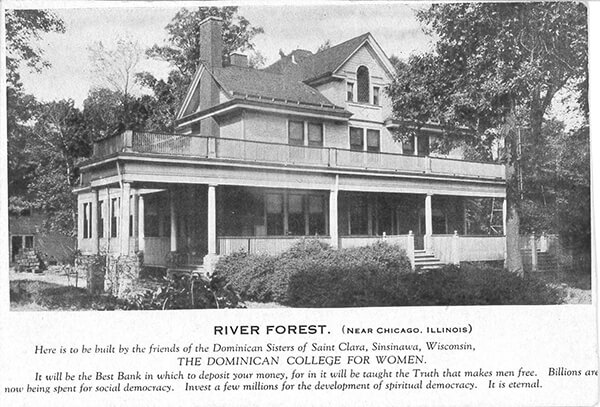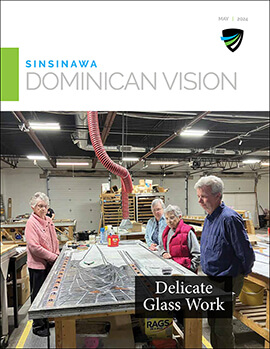Historical Decisions Pave New Paths
by Mary Paynter, OP
 As St. Clara Academy flourished in the late 19th century, and, as the Sisters’ hopes for a college began to develop, the need for a broader outreach to students was evident. When the Galena and Southwestern Railroad was built between Galena, IL, and Platteville, WI, in 1875, prospects for a nearby rail line began to seem possible. In 1880, the Chicago and Northwestern Railroad extended the line north to the Wisconsin River, and the dream of rail travel from Galena and Chicago seemed even more realistic.
As St. Clara Academy flourished in the late 19th century, and, as the Sisters’ hopes for a college began to develop, the need for a broader outreach to students was evident. When the Galena and Southwestern Railroad was built between Galena, IL, and Platteville, WI, in 1875, prospects for a nearby rail line began to seem possible. In 1880, the Chicago and Northwestern Railroad extended the line north to the Wisconsin River, and the dream of rail travel from Galena and Chicago seemed even more realistic.
When traveling along Highway 80 today out of Cuba City, WI, heading toward Platteville, St. Rose Road is on the left; the road to Benton, WI, is on the right; and a building that housed the Elmo Club restaurant is on the left. Did you know that these all held railroad and post office services for folks back in the 1870s and 1880s?
Let’s look at these 19th-century railroad stops and their post offices.
Cuba City
From Galena to Benton, the only station on the line that developed and prospered was Cuba City. A little tavern/hotel had been built there in the 1850s. However, in 1875, when the railroad became a reality and the track was laid, the village began to develop, and land lots were sold. Back then, the little settlement was known as “Uba (or “Ube”) City”—said to be a memory of the “You be damned!” arguments among the developers who arranged and sold the lots!
St. Rose
Midway between Cuba City and Elmo is St. Rose Road, the name derived from the church built there by Venerable Samuel Mazzuchelli, OP, who bought the land in September 1849. He built a small brick church that was damaged in a storm and replaced in 1859 by a small frame church. There were a few early settlers, a little store, a small tavern/hotel, and a blacksmith shop.
Elmo
Until 1854, this area was farmland. But Emanuel Whitham built a tavern/hotel called Junction House at the crossing of a road between Galena and Mineral Point, WI. In 1874, the news of a possible railroad stirred expectations, and, during the summer of 1875, a little railroad station with a post office inside was built and a store set up opposite the station. Soon a blacksmith shop and four houses were built—all with high hopes. But the grand dream faded, and, as the History of Grant County records, “Since this epoch in the history of Elmo, improvements have ceased.”
After the death of Mother Emily Power, OP (1844–1909), Mother Samuel Coughlin, OP (1868–1959), and her Council appealed to the Sisters to contribute to the construction of a Mother Emily memorial hall at Sinsinawa as part of St. Clara College, adding that this college building at Sinsinawa Mound would be feasible when a railroad would be built. In the summer of 1911, the Galena Gazette reported the probability of an inter-urban line from Freeport (IL) to Galena, with a spur for service to Hazel Green and Sinsinawa (WI). Then in 1912, it was predicted that the Dan Patch electric line would come from Dubuque (IA) and connect in Wisconsin with
Sinsinawa and then link with the Galena line.
The president of DePaul University in Chicago met with Mother Samuel and Reginald Kean, OP (unknown–1917), in 1912, telling them of the need for a women’s college in Chicago. The Sisters of the Blessed Virgin Mary had first been invited, but they withdrew from the invitation. Mother Samuel contacted the Sisters on mission regarding this new possibility—favorable responses were received, so during 1914 and 1915, various sites were considered—Madison, Milwaukee, Omaha, and Chicago as all were served by railroads!
In the fall of 1916, the students of St. Clara College were told that the new home of their college was to be in the Chicago area. Mother Emily Power’s memorial hall would be built there, and St. Clara College would be renamed Rosary College (now known as Dominican University, River Forest, IL).

